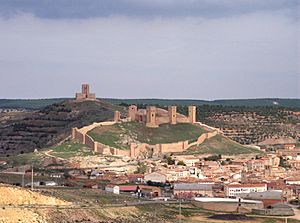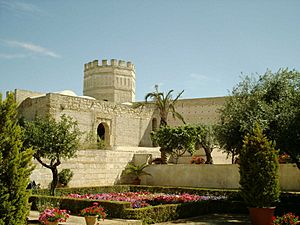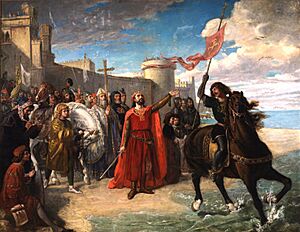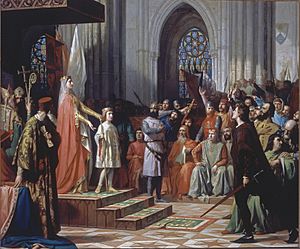Alfonso of Molina facts for kids
Quick facts for kids Alfonso |
|
|---|---|
| Lord of Molina and Mesa | |
| Reign | 1239–1272 |
| Predecessor | Mafalda González de Lara |
| Successor | Blanca Alfonso de Molina |
| Co-ruler | Mafalda González de Lara |
| Born | 1202 León |
| Died | 6 January 1272 Salamanca |
| Burial | Monastery of St. Francis in Salamanca |
| Spouse | Mafalda González de Lara Teresa González de Lara Mayor Alfonso of Meneses |
| Issue among others... |
Maria, Queen of Castile |
| House | Castilian House of Ivrea |
| Father | Alfonso IX of León |
| Mother | Berengaria of Castile |
| Religion | Roman Catholicism |
Alfonso of León, Lord of Molina (born 1202 – died 6 January 1272) was a infante (prince) from the Kingdom of León and Castile. He was the son of King Alfonso IX of León and Queen Berengaria of Castile. Alfonso was the brother of King Ferdinand III of Castile and León. He was also the father of Queen Maria of Molina, who married King Sancho IV. Alfonso became the Lord of Molina and Mesa after his first marriage to Mafalda González de Lara, who was the rightful owner of those lands.
Contents
Who Was Alfonso of Molina?
His Family Background
Alfonso was the son of King Alfonso IX of León and his second wife, Queen Berengaria of Castile. His grandparents on his father's side were King Ferdinand II of León and Urraca of Portugal. On his mother's side, his grandparents were King Alfonso VIII of Castile and Eleanor of England. Alfonso had several siblings, including King Ferdinand III of Castile and León.
Life as a Prince
Alfonso was born near the city of León in 1202. Growing up, he saw the difficult relationship between the kingdoms of León and Castile. This was especially true after his parents' marriage was ended.
In 1212, during the famous Battle of Navas de Tolosa, Alfonso's father, King Alfonso IX, did not join the other Iberian kings. Instead, he took advantage of the situation to invade Castile.
Becoming Lord of Molina
In 1222, King Ferdinand III of Castile had problems with Gonzalo Pérez de Lara, the Lord of Molina. Gonzalo supported Alfonso IX, which caused conflict. However, the two kings eventually made peace with the Treaty of Zafra in 1223. Queen Berengaria, Alfonso's mother, helped a lot in these talks.
Gonzalo Pérez de Lara had caused trouble by attacking villages near Medinaceli. He wanted to encourage Castilian nobles to rebel against Ferdinand. King Ferdinand wanted to control powerful families like the House of Lara. He laid siege to the Castle of Zafra, where Gonzalo was hiding.
Gonzalo eventually gave up. One of the main conditions was that his land, the Lordship of Molina, would not go to his son after his death. Instead, it would go to his daughter, Mafalda González de Lara. She would marry Prince Alfonso of Molina. This plan helped the Crown of Castile gain control over the Lordship of Molina.

Alfonso of Molina and Mafalda González de Lara married in 1240. When Mafalda's father died in 1243, Alfonso became the Lord of Molina through his wife. He ruled the area for the rest of his life, first with his wife and then alone after she passed away. He and later his daughter Blanca helped improve the local laws, called fueros, for the people of Molina.
People at the time said Alfonso of Molina was a good and calm person. In 1230, when his father, Alfonso IX, died, he could have tried to become King of León. His father had wanted his two daughters, Sancha and Dulce, to inherit the throne instead of Ferdinand III. However, Sancha and Dulce gave up their claim to the throne in the Treaty of Benavente in exchange for money. Alfonso of Molina had already refused the throne. Because of this, King Ferdinand III gave him many gifts, lands, and special rights. Alfonso often joined his brother in military campaigns and strongly supported the Reconquista, which was the effort to retake land from the Moors.
Military Campaigns
Battle of Jerez (1231)
In 1231, King Ferdinand III sent his brother, Alfonso of Molina, to attack the lands of the Almohad Caliphate near Córdoba and Seville. Alfonso was joined by important leaders like Álvaro Pérez de Castro.
They started from Salamanca, gathered more knights in Toledo, and then moved towards Andújar. From there, they attacked the countryside around Cordoba and later the town of Palma del Río. They captured the town and then headed towards Seville and Jerez de la Frontera. They set up camp near the Guadalete River.
The Emir Ibn Hud gathered a large army and positioned himself between the Castilians and Jerez. This forced a battle. In the fight, known as the Battle of Jerez, the Castilians defeated Ibn Hud, even though his army was much larger. King Alfonso X later said that this battle was very important. It greatly weakened the Moors and helped Christians gain control of Andalusia.

After this victory, Alfonso of Molina returned to Castile and met with King Ferdinand III in Palencia.
Conquests of Cordoba and Seville
Alfonso of Molina played a key role in important conquests. In 1236, he helped capture Cordoba, which was once the capital of the Caliphate of Cordoba. Twelve years later, in 1248, he took part in the siege of Seville. He even captured the Torre de Oro (Tower of Gold) and a part of the Alcázar of Seville, which became known as the "Walls of the Infante of Molina."

After his brother Ferdinand III died, Alfonso X became king. In 1253, when the territory of Seville was divided, Alfonso of Molina received a lot of land. This was because he was Ferdinand III's younger brother, and the late king had asked Alfonso X to treat him well.
Later Life and Death
In 1254, Alfonso of Molina joined the Order of Calatrava, a military-religious order. He wanted to be buried in their main monastery when he died. He attended important meetings of the Cortes (a type of parliament) in Valladolid in 1258 and Toledo in 1259. These meetings were mainly to raise money for King Alfonso X's plans to become the Holy Roman Emperor. He also attended a council in Jerez in 1268. In 1269, he was present at the wedding of Prince Fernando de la Cerda, King Alfonso X's oldest son, to Blanche of France.
Alfonso of Molina died in Salamanca on 6 January 1272, at the age of 70. His body was first buried in the monastery of San Francisco in Salamanca. Later, his remains were moved to Calatrava la Nueva, as he had wished in his will. He was placed in a grand tomb in the monastery's church. Sadly, this tomb and his remains are no longer there today.
Marriage and Children
Alfonso of Molina married three times and had several children.
First Marriage
In 1240, he married Mafalda González de Lara, the Lady of Molina. She was the daughter of Gonzalo Pérez de Lara. They had two children:
- Fernando Alfonso of Molina (1242–1250).
- Blanca Alfonso of Molina (1243–1292), who inherited the Lordship of Molina after her father's death. She married Alfonso Fernández de Castilla, an illegitimate son of King Alfonso X.
Second Marriage
After Mafalda died in 1244, he married Teresa González de Lara. She was the daughter of Count Gonzalo Núñez de Lara. They had one daughter:
- Juana Alfonso of Molina (born 1245/1246 – died after 1307). She married Lope Díaz III de Haro, the Lord of Biscay.
Third Marriage
In 1260, he married Mayor Alfonso de Meneses. She was the Lady of Meneses and Villanueva. They had two children:
- Alfonso Téllez of Molina (1262–1314), who became the Lord of Meneses and other lands.
- Maria of Molina (born around 1260 – died 1321). She became the Queen Consort of Castile by marrying her cousin, Sancho IV of Castile. They were the parents of King Ferdinand IV of Castile.

Other Children
Alfonso of Molina also had several children outside of marriage:
- Juan Alfonso of Molina (1225–1293), who became the Bishop of Palencia.
- Urraca Alfonso (born 1225/1230? – died ?), who married García Gómez Carrillo.
- Berengaria Fernández (born 1230/1235? – died 1272), who was the Lady of Melgoso and Caldelas. She later had a son with King James I the Conqueror of Aragon.
- Leonor Alfonso (born 1230/1235 – died ?), who married Alfonso García de Villamayor.
- Juana Alfonso (born 1266 – died ?).
See also
 In Spanish: Alfonso de Molina para niños
In Spanish: Alfonso de Molina para niños

